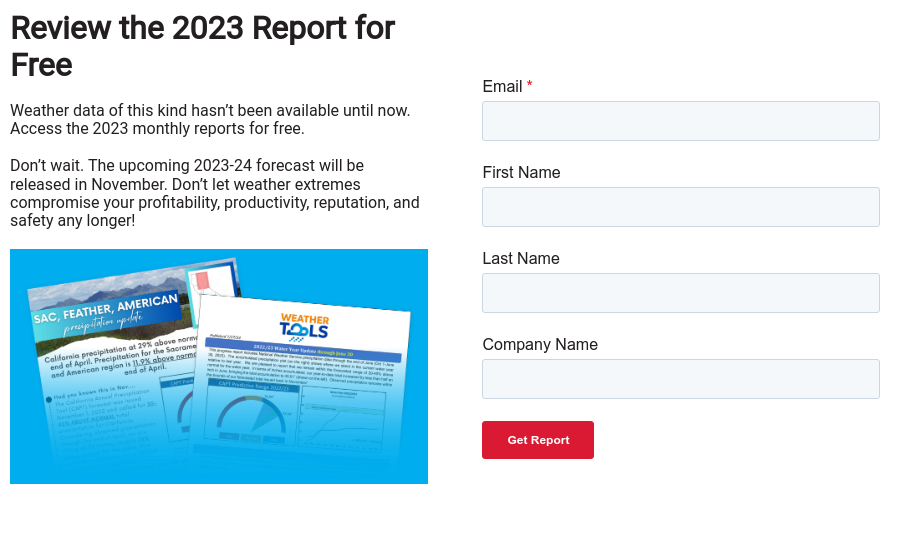Wild precipitation swings in recent years have left Californians asking, "What's next?". Weather Tools has the answer, with a groundbreaking and proven methodology for forecasting California's water year.
The Golden State endured three years of persistent drought, followed by a recent above-normal 2022-23 water year (Oct 1 - Sep. 30) that filled reservoirs and left behind a relieved populace.
There's little doubt El Niño will play a significant role in the overall weather pattern across the country in the coming months. But its effects on California's precipitation aren't as clear-cut as one may think.
Meteorologist Rob Doornbos is the founder and CEO of Weather Tools, Inc., which issues an annual report that forecasts the total water year precipitation across the state. He says both climatic patterns -- an El Niño and its sister pattern, La Niña -- have led to water year precipitation amounts on both sides of average.
"Past El Niño events have shown significant variations in their impact here in California," Rob says. "Some brought much-needed relief, with above-average rainfall and snowpack, while others fell short of expectations," he adds.
Weather patterns such as El Niño or La Niña are paramount to California's economy, considering they significantly influence the annual precipitation patterns and water resources. However, the uncertainty surrounding their outcomes underscores the complexity of the atmosphere and the importance of continued research and innovation for improved forecasts, benefiting businesses and individuals alike.
So, we asked Rob to weigh in on our El Niño questions as they relate to California's water year precipitation forecasts.
What is El Niño, and how does it typically influence California precipitation patterns?
El Niño is a climate phenomenon characterized by the periodic warming of sea surface temperatures in the central and eastern tropical Pacific Ocean. This natural occurrence has far-reaching effects on global weather patterns, making it a topic of great interest and concern for meteorologists, climate scientists, and regions vulnerable to its impacts.
Approximately two-thirds of previous El Niño occurrences in California have resulted in above-average precipitation levels, while the remaining one-third have led to below-average statewide precipitation for the water year. Weather Tools' methodology relies on significantly more than just climate pattern data to forecast precipitation accurately.
Recent research out of UCLA suggests that the periodic fluctuation of sea surface temperatures in the Pacific (referred to as ENSO) explains only about 25% of the year-by-year variability in California's precipitation and that most of the variability is explained by atmospheric circulation patterns independent of ENSO[1]. The CAP Forecast bridges that gap as its proprietary technique focuses on the requisite atmospheric processes, whether they are ENSO-associated or not.
When was the most recent El Niño, and how did Weather Tools' forecast perform?
Over the past seven years of forecasting, there has been only one El Niño year (WY 2018-2019). In that year, our forecast predicted water year precipitation amounts ranging from 120% to 140% of the normal state average. At the conclusion of the water year, independent data sources determined that the actual water year precipitation was 128% of the normal average. Alternatively, five of the past seven years were La Niña years- with precipitation amounts on either side of the normal. In all five of these years, our water year forecast correctly predicted the total water year precipitation.
Are the shifts between El Niño and La Niña something you can predict?
No, we are not capable of forecasting a shift from one climate pattern to another and it really wouldn't have an impact on our precipitation forecast as noted above. Our focus is several layers deeper into the data. After we have generated the water year precipitation forecast, we consider the El Niño or La Niña outlooks when searching for historical analogs that will add context to our monthly progress reports.
How is the Weather Tools' forecast similar/different than other long-range outlooks?
Our forecast is not based on historical, climatological data. Our consideration of the climate pattern is strictly to provide a frame of reference for our subscribers. The California Annual Precipitation forecast technique does not rely upon historical data in any way, shape, or form. Rather, it completely relies upon present-day data processed through our proprietary model to produce our WY forecast.

[1] (Why Seasonal Prediction of California Winter Precipitation Is Challenging in: Bulletin of the American Meteorological Society Volume 103 Issue 12 (2022) (ametsoc.org)
